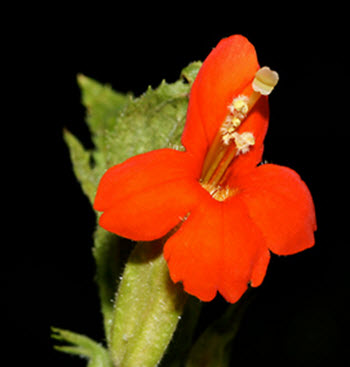The Mimulus cardinalis or “scarlet monkey flower“ is an herblike creeping perennial from the lopseed family. This beautiful native of the Californian wilds bears very enticing red or orange flowers. The cardinalis spreads fairly quickly and become a rather large plant once it has settled. Monkey flowers are also priced flowers for cultivation and its ornamental flowers is used as décor in many different gardens.
Morphology
 The cardinalis grows creeping along the ground and send up small stems that reaches 1 to 3 inches in height. The stems are branching, have small sticky white hair and are a yellowish green color. The monkey flowers leaves grow opposite, they are almond shaped, have small sharp teeth along the edge and are pale green. Its flowers are solitary and are shaped like a trumpet, with a wide opening to the front and a tubular chamber to the back and are up to 2 inches long and as the name implies the flowers a colored a bright and captivating scarlet red (in very rare cases, yellow).
The cardinalis grows creeping along the ground and send up small stems that reaches 1 to 3 inches in height. The stems are branching, have small sticky white hair and are a yellowish green color. The monkey flowers leaves grow opposite, they are almond shaped, have small sharp teeth along the edge and are pale green. Its flowers are solitary and are shaped like a trumpet, with a wide opening to the front and a tubular chamber to the back and are up to 2 inches long and as the name implies the flowers a colored a bright and captivating scarlet red (in very rare cases, yellow).
Habitat
When it comes to which conditions a Mimulus cardinalis requires the first thing it needs is moisture, the soil it stands in must never dry out, which is why it prefers partial shade to full sun. You can find them close to rivers and lakes, close to the shoreline and they can even tolerate short flooding and being completely submerged for short periods of time. All of this combined means you will often find them in wetlands, foothill woodlands, valley grassland and subalpine forests. Even though the Mimulus cardinalis are wide spread throughout California, the highest population concentration is found in the southwestern part.
Native Gardening
For the gardener the scarlet monkey plant can be both useful and a source of beauty. The scarlet monkey plant attracts lots of hummingbirds, which the plant’s flowers are specially adapted to and who do not want to have their garden swarming with little hummingbirds. Of cause you can also uses them as an ornamental, just for the sheer beauty of their vibrant flowers, which can quickly cover up large amounts of ground. And then for the practical usefulness, because of its tolerance to standing water and minor floodings, it is a great plant to use for edging small streams or ponds to avoid erosion. And as a part of the local native environment in California, it will thrive well in your little piece of nature and live harmonious with its surrounding.

